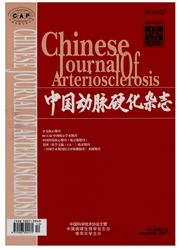

 中文摘要:
中文摘要:
目的 探讨电场作用下血管平滑肌细胞膜表面细胞生长因子受体表达的变化及其时细胞增殖迁移的影响。方法 通过电场实验小室,对体外培养的大鼠主动脉血管平滑肌细胞给予直流电场干预,间断显微细胞图像记录和分析,研究不同强度电场、不同作用时间下血管平滑肌细胞迁移和细胞形态的变化;采用免疫细胞化学或免疫荧光染色方法,检测电场干预后与血管平滑肌细胞迁移密切相关的血小板源生长因子受体、血管紧张素Ⅱ1型受体和2型受体等受体的表达情况。结果 ①150V/m电场长时间作用下,培养的血管平滑肌细胞有明显的电场趋化性,细胞向负极迁移的距离明显高于无电场作用的对照组。②改进的电场干预装置作用下,血管平滑肌细胞膜血小板源生长因子受体表达增加,部分细胞内血小板源生长因子受体表达上调,呈不对称分布,在电场负极面较集中;细胞中血管紧张素Ⅱ1型受体表达亦增加,但无明显不对称分布现象;血管紧张素Ⅱ2型受体表达改变不显著。结论 外加直流电场干预下,大鼠血管平滑肌细胞发生形状改变和定向迁移。血管平滑肌细胞中血小板源生长因子受体和血管紧张素Ⅱ1型受体表达上调和重分布,可能与细胞定向迁移的启动和维持有关。
 英文摘要:
英文摘要:
Aim To study the change of cellular growth factor receptor and its effect on the proliferation and migration of vascular smooth muscle cells (VSMC) under electrical field. Methods An electrophoresis apparatus was designed for applying the direct current electric fields to the cultured VSMC, which got from the aorta of rat. Interval photographs were used to analyse the direction and distance of VSMC migration. The cellular growth factors such as platelet derived growth factor receptor [PDGFR), angiotensin Ⅱ type 1 receptor (AT1R) and its type 2 receptor [AT2R) were studied by immunohistochemistry or immunofluorescence to show the mechanism relation to the migration of VSMC. Results The longer time of exposure to the 150 V/m electric field, the mere electrotaxis the cells showed, that is, the distance of cellular migration incresed obviously with the time of exposure to the electric field compared with control group. Under the direct current electric field, the expression of PDGFR were increased obviously and distributed asymmetricly on the membrane of VSMC. This receptor were mainly focused on the cathodal side of cellular membrane in electric field. The AT1R were also enhanced in the cells after exposure to the electric field, and the expression of AT2R had showed the changeless. Conclusion Our study indicates that electric fields applied to the rat VSMC can change the growth characteristic and increase the directly migration of VSMC. These effects maybe relate to the up-regulated expression and re-distribution of some cellular growth factors such as PDGFR, AT1R and AT2R.
 同期刊论文项目
同期刊论文项目
 同项目期刊论文
同项目期刊论文
 期刊信息
期刊信息
